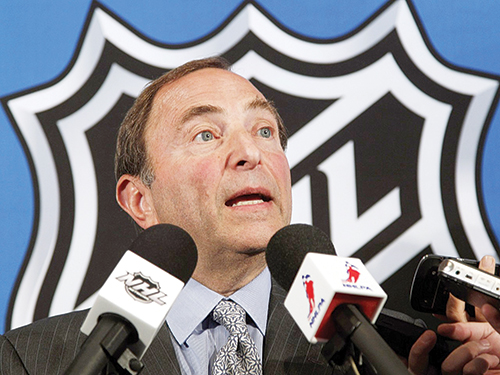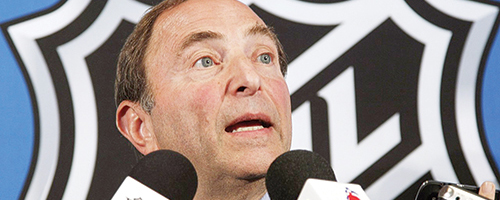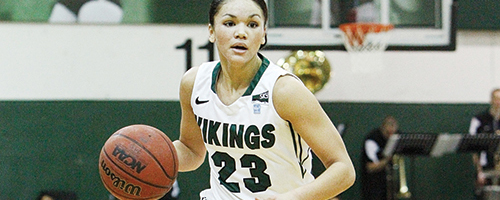From 1958 to 1992, the National Hockey League enjoyed three-plus decades of labor peace. But the fraternity between the owners and players was merely a facade—a concord based on collusion—and the exploitative relationship between the NHL and the Players’ Association’s first director smoldered for 30 years before the peace was revealed to be a carefully manipulated mirage. As the NHL prepares its return to the ice after 113 days of the most recent chapter in the league’s contentious history of labor relations, the underlying issues that led to the fourth labor stoppage in two decades still linger.
The lockout, part 1: a legacy of discontent
 Impasse: Commissioner Gary Bettman has been at the helm for the past three workstoppages in the NHL. As the league struggles to expand into new markets, professional hockey has found itself embroiled in contentious negotiations between the owners and players. Photo © Mary Altaffer/AP
Impasse: Commissioner Gary Bettman has been at the helm for the past three workstoppages in the NHL. As the league struggles to expand into new markets, professional hockey has found itself embroiled in contentious negotiations between the owners and players. Photo © Mary Altaffer/AP
From 1958 to 1992, the National Hockey League enjoyed three-plus decades of labor peace. But the fraternity between the owners and players was merely a facade—a concord based on collusion—and the exploitative relationship between the NHL and the Players’ Association’s first director smoldered for 30 years before the peace was revealed to be a carefully manipulated mirage. As the NHL prepares its return to the ice after 113 days of the most recent chapter in the league’s contentious history of labor relations, the underlying issues that led to the fourth labor stoppage in two decades still linger.
The discontent between the two sides first began to simmer during the 1957–58
season, when a group of prominent players from the NHL’s six franchises banded together to form a fledgling union after the league had stonewalled player attempts to learn more about their pension plan. Led by Detroit Red Wings captain Ted Lindsay, the union found itself swiftly contested by the owners. Lindsay and other players were traded or threatened with exile to the minor leagues. Settling out of court, the players shelved their organization efforts for another decade.
When the NHL expanded for the first time in 1967, the players succeeded in forming a union under the leadership of Alan Eagleson. A lawyer and player agent who had represented Bobby Orr and other superstars of the era, Eagleson led the NHL Players’ Association for its first 25 years. His leadership, however, proved to be more conspiratorial than constructive.
Aligning himself with longtime NHL President John Ziegler and Chicago Blackhawks owner Bill Wirtz, Eagleson worked with the league to deflate athletes’ salaries and keep the majority of hockey revenue in the hands of the owners. In 1998, six years after Eagleson was voted out of his position as the NHLPA’s second executive director in favor of former journeyman hockey player and attorney Bob Goodenow, the longtime union leader was convicted of fraud and embezzlement after his extradition to the United States.
Goodenow’s first few months were marked by a 10-day player strike, which restored to the players the right to market their own images. (Previously, a player’s team held the right to a player’s sponsorship potential.) The success of the strike bolstered the collective membership of the league’s rosters, presaging the first long work stoppage in league history.
When the summer of 1994 rolled around, the NHL had played its last season without a collective bargaining agreement and was dealing with a true union leader for the first time. The league had also reorganized, replacing the post of president with a new commissioner—Gary Bettman. Hired away from the NBA in 1993, Bettman was as fully prepared for a showdown as his counterpart in the NHLPA.
Acting on behalf of owners who wanted to establish a salary cap, Bettman and the NHL locked out the players on Oct. 1, 1994. As the two sides argued over the cap, as well as the NHLPA’s desire for revenue-sharing between the most lucrative franchises and smaller markets, three months passed without a resolution, and 468 games were lost from the schedule as a result. Breaking from the rest of the ownership, a group of large-market teams led by Toronto forced a compromise on the salary cap issue, and a new CBA was negotiated in time to play a 48-game season.
The league experienced unprecedented growth over the next decade as the explosion of revenues saw the rise of individual contracts and exponential increases in team valuations. In the aftermath of the lockout, a relocation movement coincided with rapid expansion as the league chased a southward demographic shift. Collecting expansion fees and lusting after large TV markets, the NHL ballooned from 21 teams in 1992 to 30 teams
in 2001.
The expansion was a blessing and a curse, earning the NHL short-term respect as a national brand with a series of TV deals but also creating the long-term dilemma of having to prop up markets with little hockey history and little willingness to support their local teams at the turnstiles. As popularity plateaued and salaries continued to rise, the owners called again for a salary cap. Resistance from the NHLPA would lead to the 2004–05 lockout.
Demanding a rollback across the board by the players as well as a salary cap pegged to a percentage of hockey-related revenue, the owners shut down the league for the entire season as both sides remained recalcitrant in negotiations. The owners, digging their heels in, eventually forced the players to capitulate on a majority of the league’s requests.
Returning for the 2005–06 season, the NHL assumed it had finally gained every concession possible to become a juggernaut in the North American sports scene. Despite the early damage of the lost season and the lack of a large TV deal, the league slowly regained its footing and appeared to be on its
way back.
An uneasy truce seemed to emerge as the early concessions by the players ultimately led to a steady rise in hockey revenues. But those revenues largely went to the flagship franchises as the lack of revenue sharing and the specter of overzealous expansion continued to hover over the league. Even as teams like Carolina, Anaheim and Tampa Bay found success on the ice, they continued to bleed red in their financial statements. A salary cap, with an attendant salary floor, proved anathema for small-market teams, since it forced them to spend beyond their means.
Owners continued to pine for the days of collusion with the NHLPA, and players continued to feel belittled by the men who signed their paychecks. Under the surface remained all the ingredients that led to the NHL’s first three labor impasses, just waiting to be unearthed once the CBA expired again.
Be on the lookout for part two of this article in the coming weeks.







